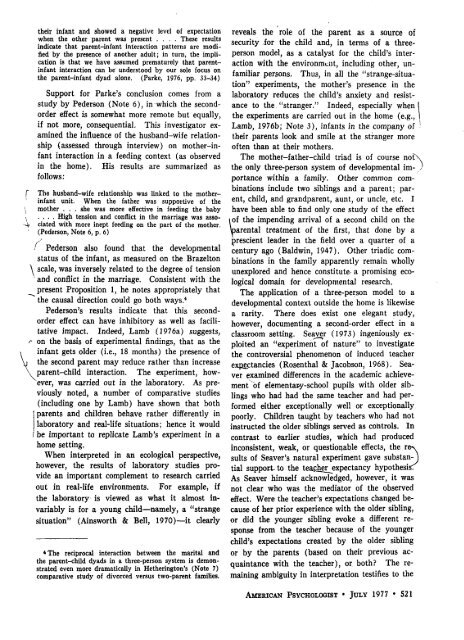Bronfenbrenner 1977
Create successful ePaper yourself
Turn your PDF publications into a flip-book with our unique Google optimized e-Paper software.
their infant and showed a negative level of expectation<br />
when the other parent was present . . . . These results<br />
indicate that parent-infant interaction patterns are modified<br />
by the presence of another adult; in turn, the implication<br />
is that we have assumed prematurely that parentinfant<br />
interaction can be understood by our sole focus on<br />
the parent-infant dyad alone. (Parke, 1976, pp. 33-34)<br />
Support for Parke's conclusion comes from a<br />
study by Pederson (Note 6), in which the secondorder<br />
effect is somewhat more remote but equally,<br />
if not more, consequential. This investigator examined<br />
the influence of the husband-wife relationship<br />
(assessed through interview) on mother-infant<br />
interaction in a feeding context (as observed<br />
in the home). His results are summarized as<br />
follows:<br />
f The husband-wife relationship was linked to the motherinfant<br />
unit. When the father was supportive of the<br />
', mother ... she was more effective in feeding the baby<br />
• .... High tension and conflict in the marriage was asso-<br />
-V dated with more inept feeding on the part of the mother.<br />
' (Pederson, Note 6, p. 6)<br />
• Pederson also found that the developmental<br />
status of the infant, as measured on the Brazelton<br />
\ scale, was inversely related to the degree of tension<br />
and conflict in the marriage. Consistent with the<br />
present Proposition 1, he notes appropriately that<br />
the causal direction could go both ways. 4<br />
Pederson's results indicate that this secondorder<br />
effect can have inhibitory as well as facilitative<br />
impact. Indeed, Lamb (1976a) suggests,<br />
/• on the basis of experimental findings, that as the<br />
infant gets older (i.e., 18 months) the presence of<br />
the second parent may reduce rather than increase<br />
parent-child interaction. The experiment, however,<br />
was carried out in the laboratory. As previously<br />
noted, a number of comparative studies<br />
(including one by Lamb) have shown that both<br />
parents and children behave rather differently in<br />
laboratory and real-life situations; hence it would<br />
be important to replicate Lamb's experiment in a<br />
home setting.<br />
When interpreted in an ecological perspective,<br />
however, the results of laboratory studies provide<br />
an important complement to research carried<br />
out in real-life environments. For example, if<br />
the laboratory is viewed as what it almost invariably<br />
is for a young child—namely, a "strange<br />
situation" (Ainsworth & Bell, 1970)—it clearly<br />
*The reciprocal interaction between the marital and<br />
the parent-child dyads in a three-person system is demonstrated<br />
even more dramatically in Hetherington's (Note 7)<br />
comparative study of divorced versus two-parent families.<br />
reveals the role of the parent as a source of<br />
security .for the child and, in terms of a threeperson<br />
model, as a catalyst for the child's interaction<br />
with the environment, including other, unfamiliar<br />
persons. Thus, in all the "strange-situation"<br />
experiments, the mother's presence in the<br />
laboratory reduces the child's anxiety and resistance<br />
to the "stranger." Indeed, especially when<br />
the experiments are carried out in the home (e.g., \<br />
Lamb, 1976b; Note 3), infants in the company of '<br />
their parents look and smile at the stranger more<br />
often than at their mothers.<br />
The mother-father-child triad is of course not\<br />
the only three-person system of developmental im- ,<br />
portance within a family. Other common combinations<br />
include two siblings and a parent; parent,<br />
child, and grandparent, aunt, or uncle, etc. I<br />
have been able to find only one study of the effect<br />
i of the impending arrival of a second child on the<br />
parental treatment of the first, that done by a<br />
prescient leader in the field over a quarter of a<br />
century ago (Baldwin, 1947). Other triadic combinations<br />
in the family apparently remain wholly<br />
unexplored and hence constitute- a promising ecological<br />
domain for developmental research.<br />
The application of a three-person model to a<br />
developmental context outside the home is likewise<br />
a rarity. There does exist one elegant study,<br />
however, documenting a second-order effect in a<br />
classroom setting. Seaver (1973) ingeniously exploited<br />
an "experiment of nature" to investigate<br />
the controversial phenomenon of induced teacher<br />
expectancies (Rosenthal & Jacobson, 1968). Seaver<br />
examined differences in the academic achievement<br />
of elementapy-school pupils with older siblings<br />
who had had the same teacher and had performed<br />
either exceptionally well or exceptionally<br />
poorly. Children taught by teachers who had not<br />
instructed the older siblings served as controls. In<br />
contrast to earlier studies, which had produced<br />
inconsistent, weak, or questionable effects, the re><br />
suits of Seaver's natural experiment gave substan-J<br />
tial support to the teacherjexpectancy hypothesis:<br />
As Seaver himself acknowledged, however, it was<br />
not clear who was the mediator of the observed<br />
effect. Were the teacher's expectations changed because<br />
of her prior experience with the older sibling,<br />
or did the younger sibling evoke a different response<br />
from the teacher because of the younger<br />
child's expectations created by the older sibling<br />
or by the parents (based on their previous acquaintance<br />
with the teacher), or both? The remaining<br />
ambiguity in interpretation testifies to the<br />
AMERICAN PSYCHOLOGIST • JULY <strong>1977</strong> • 521


